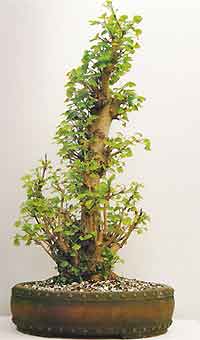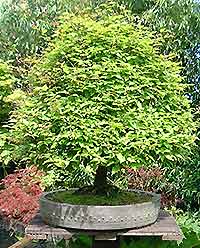Bonsai Trees
Choosing Pots

Bonsai pots come in a wide variety of shapes and sizes. When chosen carefully, a pot will help to transform and complete the overall image of the tree. A pot which has been well matched to a bonsai can greatly enhance the appearance.
Often, a developing bonsai tree may spend many years in a variety of training pots before being planted in its final container.
The following are basic guidelines to consider when selecting a bonsai pot:

- Never plant a tree in a bonsai pot if the roots will need to be drastically pruned in order to fit into the pot. If necessary reduce the root ball and pot size gradually over a period of years
- Bonsai pots must always have adequate drainage and be frost proof
- The inside of a pot should be unglazed so that the roots can grip the interior firmly
- Conifers are most suited to unglazed pots in natural colours of browns and greys
- Deciduous trees lend themselves to either unglazed or glazed pots of all colours, although subtle, subdued shades are usually most appropriate. Consider how the pot will blend with any strong autumn colours
- Flowering trees are often planted in glazed pots of brighter colours, such as blues, creams, greens and whites
- If you are unsure what pot colour to chose, select a shade that is similar to that of the tree's trunk
- Formally shaped trees look best in angular, straight edged pots with sharp corners, usually rectangular
- Less formal styles suit most shapes of pot, including rectangular with rounded corners, oval and round
- Literati trees are usually potted in round pots which can be primitive in design
- Cascade and semi cascade trees require deep pots, both for stability and visual balance
- Group plantings should be potted in large shallow pots or slabs of rock, allowing a natural landscape to be created
- Delicate trees can be matched with more fancy, dainty pots which may have ornate feet
- Small trees can be planted in large pots to create a more landscaped feeling: Conversely large trees can be effectively underpotted to appear more dominant and powerful
- Usually, the length of a pot should be approximately 2/3 the height of a tree, or if it is a wide, spreading bonsai, 2/3 of the width. Tall, thin trees may however look better in smaller pots
- The depth of a pot should be roughly the diameter of the trunk base, therefore deep pots suit trees with thick trunks, whereas slender trunked trees or bonsai grown over a rock are best planted in shallower pots
- Pots can be made to appear shallower by visual tricks that break up the surfaces, thus deceiving the eye. Pot bands, inset rectangular outlines, studs and partial glazing all achieve this
- Highly glazed pots will soften in colour as time passes. This aging process can be speeded up by actually wiping the glaze with a dark staining wood scratch remover or similar fine oil
- The pot should enhance the bonsai tree and not be overpowering or a dominant feature. It should harmonise and complement the characteristics of the tree, showing the bonsai off to its best advantage
 Bonsai pots come in a wide variety of shapes and sizes. When chosen carefully, a pot will help to transform and complete the overall image of the tree. A pot which has been well matched to a bonsai can greatly enhance the appearance.
Bonsai pots come in a wide variety of shapes and sizes. When chosen carefully, a pot will help to transform and complete the overall image of the tree. A pot which has been well matched to a bonsai can greatly enhance the appearance.